Table of contents
- PS-Technik series part 14 Wheels and rims
- The spokes
- Not better, but cheaper: the Comstar composite bike
- Cast wheels from the very beginning
- A daring step
- With a bike, the weight counts twice
- The wheel – movement and standstill at the same time
- Function and loading of wire-spoke wheels
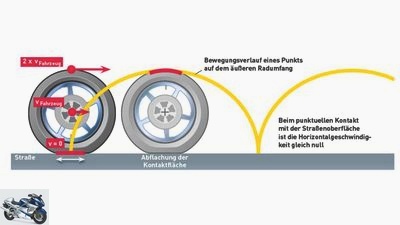
archive
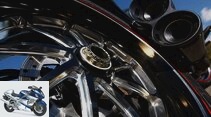
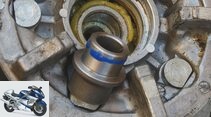
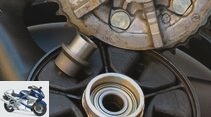
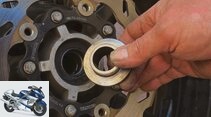
17th pictures
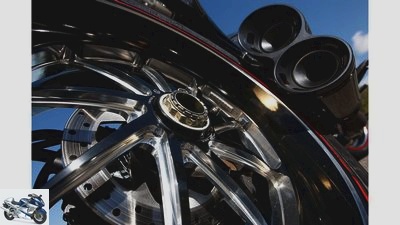
archive
1/17
Axle, spokes, rim – the wheel is ready. However, motorcycles, and especially fast sports motorcycles, place high demands on the circular components.
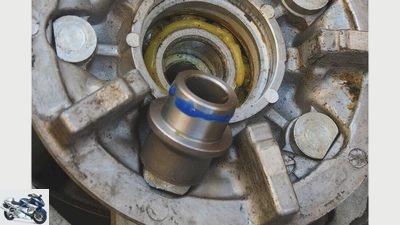
Cook
2/17
To avoid this, the sleeve is inserted into the ball bearing with a bearing adhesive (blue).
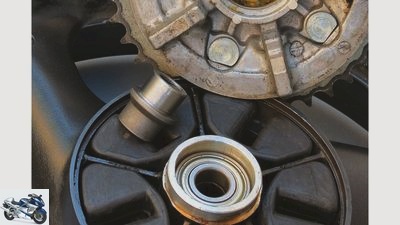
Cook
3/17
Caution: the spacer sleeve between the sprocket carrier and the wheel tends to fall out of place. If it is forgotten, the rear wheel can lock up.
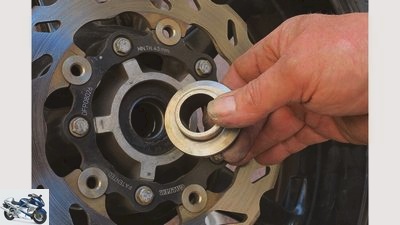
Cook
4/17
All spacer sleeves are removed before the tire change and are placed in our tub.

Cook
5/17
Axle and nut do not belong on the asphalt or workshop floor, but in a tub and are treated with MoS2 spray before installation.

Cook
6/17
In order not to scratch the shiny surface of some aluminum swingarms with the chain, a strip of tape is stuck on.

archive
7/17
Circumferential forces: When braking, only the spokes under tension (red) can transmit the torque from the hub to the rim. Conversely, when you accelerate, the yellow pair of spokes drive the wheel through the pulling force.
Wheel load: The wheel load acting on the hub (red arrow) can only be transferred to the rim by the spokes marked in red, while the yellow spokes of the rim allow elastic deformation at the contact point.
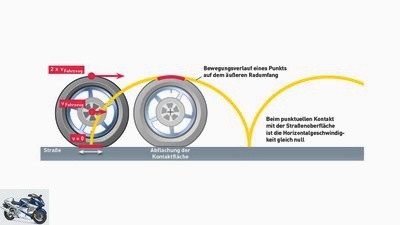
archive
8/17
The wheel – movement and standstill at the same time. A defined tire contact point does not describe a circle while driving, but an arc-shaped movement that is constantly repeated.

archive
9/17
Forged and then milled ten-spoke wheels with extremely thin and therefore light rim beds guarantee the best handling due to the low rotating mass. The fiber flow of the compacted material created during forging ensures a high level of break resistance.
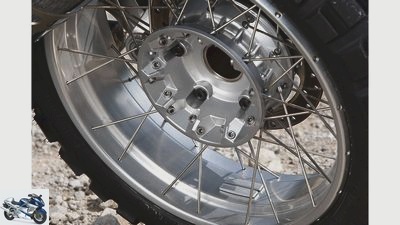
archive
10/17
Right on trend: In the large-scale series, here the BMW R 1200 GS Adventure, beautiful wire-spoke wheels with tubeless tires are being used again.
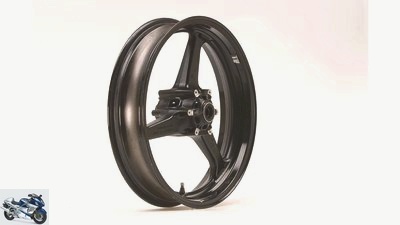
archive
11/17
The three-spoke wheel with hollow-cast spokes was the measure of all things for a long time, but required stable and therefore heavy rim rings.

archive
12/17
Comstar wheels with the hub over stamped aluminum sheet-“Spokes” was riveted to the one-piece and airtight aluminum rim.
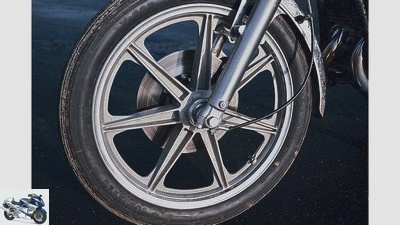
archive
13/17
The first cast aluminum wheels in the mid-1970s were significantly heavier, but maintenance-free and cheaper than the wire-spoke wheels installed up until then.
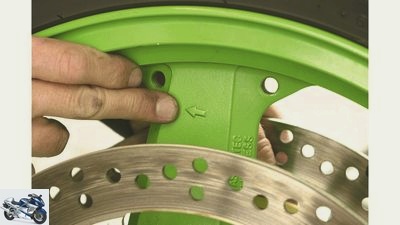
archive
14/17
Cast-in direction arrow on a front cast wheel.

archive
15/17
Front wheel rim with drop center, the airtight hump that securely clamps the tire on the rim and the rim flange that closes off to the outside.
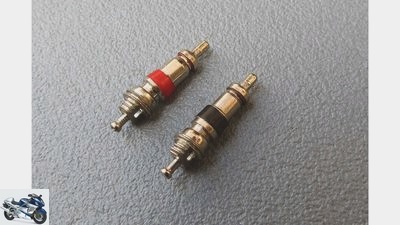
archive
16/17
Valve inserts with red PTFE seal for high temperatures in racing, black sealing ring for normal operation.
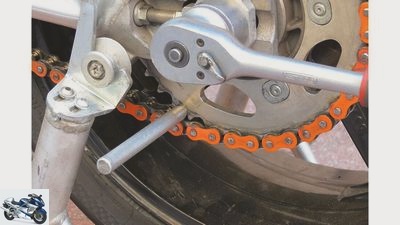
Cook
17/17
When tightening the axle nut, an approximately 9 mm aluminum mandrel is clamped between the chain and the sprocket in order to press the axle fully against the tensioner.
accesories
tire
Wheels rims
PS-Technik series part 14
Wheels and rims
Content of
Axle, spokes, rim – the wheel is ready. Everything you always wanted to know about wheels and rims can be found here in PS Knowledge Technology Part 14.
Werner Koch
05/20/2014
Axle, spokes, rim – the wheel is ready. However, motorcycles, and especially fast sports motorcycles, place high demands on the circular components. So that nothing breaks when braking, accelerating and cornering at an angle, the wheel constructions must be adapted to the enormous forces and bending loads. And they have to be tight in order to guarantee the air pressure in the tire over the long term. In addition to the precisely fitting rim hump, the valves, which are mostly used in the rim base, are used for this purpose, with different sealing rings and sometimes stronger valve springs, even when the centrifugal force tries to force the valve out of its seat at high speed. So never forget: the valve cap, preferably made of metal with a sealing ring instead of the cheap plastic caps.
Buy complete article
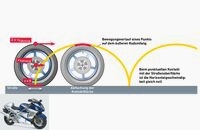
PS-Technik series part 14
Wheels and rims
6 pages) as PDF
€ 2.00
Buy now
The dimensions of the rim determine which tire size can be fitted. The following parameters are defined for the so-called standard rim: tire diameter in inches, internal width, as rim width in inches, type of seal (rim hump) and the design of the rim well and the rim flanges. The rim dimensions are always the same for all wheels, regardless of whether they are spoke or cast. And watch out: even symmetrical front wheels have a predetermined direction of travel, which is indicated by an arrow.

workshop
PS technology special
Further training for motorcyclists
read more
The spokes
Up to the beginning of the 1970s, almost all motorcycles rolled on the technically and visually ingenious wire-spoke wheels. Ingenious because the three components hub, spokes and rim could be replaced relatively easily in the event of damage. In addition, the spoke corset guarantees the rim ring certain spring properties that were conducive to driving comfort, especially on bad roads. One of the reasons why all motocross and enduro machines have only been fitted with wire-spoke wheels to this day. Attempts with cast and composite wheels in the 80s were soberly called off after a few off-road use.
The disadvantage of the industrial large-scale production was the relatively high weight and the threading and tensioning of the usual 36 or 40 spokes, which can mostly only be done by hand. Ultimately, resilience and durability depended on the even and correct tension of the spokes. Irregularly tightened, the drive and braking forces of the bike were only transmitted to the excessively pretensioned spokes, which ultimately broke under the high tensile load. Then the originally round wheel becomes a tumbling disc, the so-called “figure eight”.
Actually long since retired, the classic wire-spoke wheel is not only experiencing a revival through the retro wave that was never thought possible. With new technology and high-quality materials, even extremely wide 6-inch rims for powerful motorcycles can be safely and stably integrated into the spoke corset. Airtight or anchored outside the rim bed, the spoked wheels can also be fitted with tubeless tires without any problems. And so it is not surprising that even series machines such as the classic Honda CB 1100 or the massive Horex VR 6 are again being delivered with beautiful wire-spoke wheels.
Not better, but cheaper: the Comstar composite bike
It was Honda, of all people, who rushed ahead and put their motorcycles on so-called “Comstar bikes” in the mid-1970s. Here, the hub and the airtight aluminum rim, which is suitable for tubeless tires, were connected with sheet metal profiles. Permanently screwed and riveted, hardly lighter and characterized by a rather cheap look, these composite wheels were only suitable as a transitional solution up to the era of cast wheels. In addition, loose, irreparable rivet connections caused trouble among Honda customers.
The composite principle was still used in racing with a mix of magnesium spokes, screwed to super-light carbon fiber rims, before the first complete carbon fiber wheels caused a sensation. A sensation, however, in a more negative sense. Of all people, Honda works driver Freddie Spencer broke the rear wheel during tests with a 500cc racing machine, which caused the multi-world champion to take off in a devilish way. Today, however, carbon fiber components can withstand brutal loads and long-term use without wounds.
Cast wheels from the very beginning
We shudder to remember the bulky and leaden seven-spoke Yamaha cast wheels of the RD and XS series, which gave the graceful machines the formal light-footedness of a handicapped elephant.
The reason for the extremely solid construction was the casting technique, which was still problematic at the time. Material weakened by air inclusions, so-called casting cavities, made the oversized strength necessary, because continuous controls using ultrasound or X-rays were not to be paid for in large-scale production.
These controls would have been advisable for the many small manufacturers of cast magnesium wheels in the 1970s. In many backyard dumps, feather-light (specific weight magnesium 1.8 to 2.75 g / cm³ of aluminum), but also brittle wheels for racing use emerged. KUMA (Helmut Kustermann) in Germany or SMAC (Eric Offenstadt) from France, as pioneers of lightweight construction, supplied the racing scene with their sensitive products. Falls and accidents caused by broken wheels were the order of the day, also because the corrosion-sensitive magnesium alloys literally dissolved with the slightest damage to the coated surface.
A daring step
In the meantime, in large-scale production, attempts were made to reconcile weight and stability with a statically well thought-out spoke system. With double spokes, arranged radially or tangentially, curved or straight, in Y-shape or as a cross, the aim was to give the wheels a dynamic shape.
The daring step to the light and yet sufficiently stable three-spoke wheel in the mid-1980s was corrected again in the backward somersault. Multi-spoke wheels, partly designed as a Y-construction, which guaranteed better stability under extreme loads when using thin rim beds, have replaced the three-spoke constructions in recent years. In addition, because of the thin-walled U-profiles in the spokes and hollow cast hubs, there is also room for downward movement in terms of weight and rotating masses.
However, progress in this regard will no longer take place in the areas in which we have slimmed down in the past 20 years. While the 2.50 x 17-inch front wheel of a 1988 Honda Hawk 650 weighed a whopping 5.1 kilograms, the 3.50 x 17-inch wheel of a Honda CBR 600 RR weighs just 3.8 kilograms today
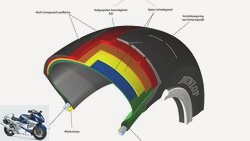
tire
PS knowledge tire lexicon
The ABC of tires
read more

tire
The 2013 PS sports tire test
6 sports tires in the horsepower test
read more
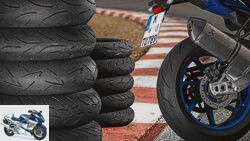
tire
PS sports tire test 2014
Six sports tires in comparison
read more

tire
6 sports tires tested (120/70 ZR 17 and 190/55 ZR 17)
High-tech import from racing
read more

tire
Touring tires of size 120/70 ZR 17 and 180/55 ZR 17 in the test
Sun, rain, durability
read more
With a bike, the weight counts twice
The weight in general and that of the rotating masses in particular is the focus of the designers. Light wheels have the advantage that they not only reduce the overall weight, but also reduce the rotating inertia forces that arise when accelerating. The wheel has to be accelerated twice, so to speak, which worsens performance and increases fuel consumption.
In addition, the lighter the wheels, which are part of the unsprung vehicle mass, improve the suspension comfort, the responsiveness and the maneuverability of the machine. In a comparison test of current high-tech bikes in Issue 10/2012 to find out.
And so it is not surprising that the wheel will not be reinvented in the future either, but will be optimized down to the last detail. These include the drop-forged magnesium or aluminum wheels. Sometimes still very complex to manufacture, the components for racing are peeled off gram for gram in the CNC machining after the rough production in the forging die in the CNC machining. What remains are extremely filigree, almost fragile-looking multi-spoke wheels with wafer-thin walls on the spokes and rim base.
The wheel – movement and standstill at the same time
The wheel, the simplest thing in the world, turns around the axis – done. But did you also know that the bike can be quite complicated as the ideal means of transport? Because it is not the wheel that transports our motorcycle, but the axle. The wheel, on the other hand, rotates around the center, i.e. precisely this axis. The circumferential speed of the tire (without slip) corresponds exactly to the driving speed of the motorcycle. In our example, the machine, and with it the axle, rolls over the asphalt at a constant 100 km / h. If you measure the speed at the outer diameter of the tire from a fixed point on the road surface, it turns out that the relative speed of the tire at the contact point is reduced to zero. The axle rolls over the tire contact point, so to speak.
In contrast, the tire reaches twice the speed exactly above the axle, i.e. 200 km / h, because the driving speed of the axle / vehicle and the circumferential speed of the tire add up (see sketch below). Only when a certain slip occurs, i.e. a slight spin of the tire, the standstill at the point of contact on the road is over. This process becomes very clear when looking at a tracked vehicle. There the lower chain strand of the drive chain stands still relative to the ground, while the axles roll over it. A defined tire contact point does not describe a circle while driving, but an arc-shaped movement that is constantly repeated (see sketch above).
Function and loading of wire-spoke wheels
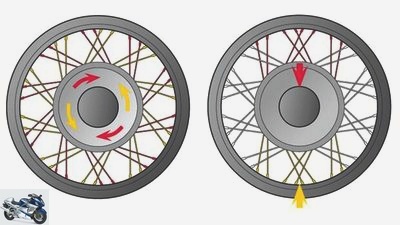
archive
Function and loading of wire-spoke wheels.
Circumferential forces
When braking, only the spokes under tension (red) can transmit the torque from the hub to the rim. Conversely, when you accelerate, the yellow pair of spokes drive the wheel through the pulling force.
Wheel load
The wheel load acting on the hub (red arrow) can only be transferred to the rim by the spokes marked in red, while the yellow spokes of the rim allow elastic deformation at the contact point.
Related articles
-
Screwdriver tip: retreading wheels
Ralf Petersen 15th pictures Suzuki 1/15 So that everything runs smoothly. The screwdriver tip for everything to do with bikes. Ralf Petersen 2/15 What…
-
Thyssenkrupp carbon rims for Honda CBR 1000 RR-R Fireblade
Thyssenkrupp accesories landing gear & Spring elements Thyssenkrupp carbon rims for Honda CBR 1000 RR-R Fireblade Thyssenkrupp Carbon rims for Honda CBR…
-
The history of GS: a career on two wheels
BMW motorcycles The history of GS: a career on two wheels The history of GS: a career on two wheels Gaudi Max Who dares wins: The R 80 G / S was the…
-
Guide to repairing spoked motorcycle wheels part 2
Marcel Schoch 15th pictures Marcel Schoch 1/15 The spokes, which are already slightly under tension after they have been lightened, lie firmly in the…
-
Thyssenkrupp carbon rims Aprilia RSV4 and Tuono
Thyssenkrupp accesories landing gear & Spring elements Thyssenkrupp carbon rims Aprilia RSV4 and Tuono Thyssenkrupp Aprilia carbon rims Lightweight…
-
jkuenstle.de Sports & scene Events Scene – Wheels & Waves Scene – Wheels & Waves Extravaganza Content of The fourth edition of Wheels & As was to be…
-
Royal Enfield at Wheels & Waves 2019
Royal Enfield 6th pictures Royal Enfield 1/6 Royal Enfield Nought Tea GT. Royal Enfield 2/6 Royal Enfield MJR Roach. Royal Enfield 3/6 Royal Enfield “The…
-
Thyssenkrupp carbon rims for Kawasaki Z 900 RS
Thyssenkrupp accesories landing gear & Spring elements Thyssenkrupp carbon rims for Kawasaki Z 900 RS Thyssenkrupp Kawasaki Z 900 RS Carbon rims for the…
-
Sven Wedemeyer Sports & scene Motorsport Wheels and Waves 2017 Wheels and Waves 2017 Peak punk Content of FUEL has always been euphoric about Wheels for…
-
Heckling – “Festival Wheels and Waves”
BMW motorcycle Sports & scene Events Interjection – &# 34; Festival Wheels and Waves&# 34; Interjection – “Festival Wheels and Waves” Buck ‘n’ Roll…